Yaralla Botanical Walking Tour
Brush box trees or tubbil-pulla
Lophostemon confertus
| Stop: 1 |
| Location: Along main entrance roadway |
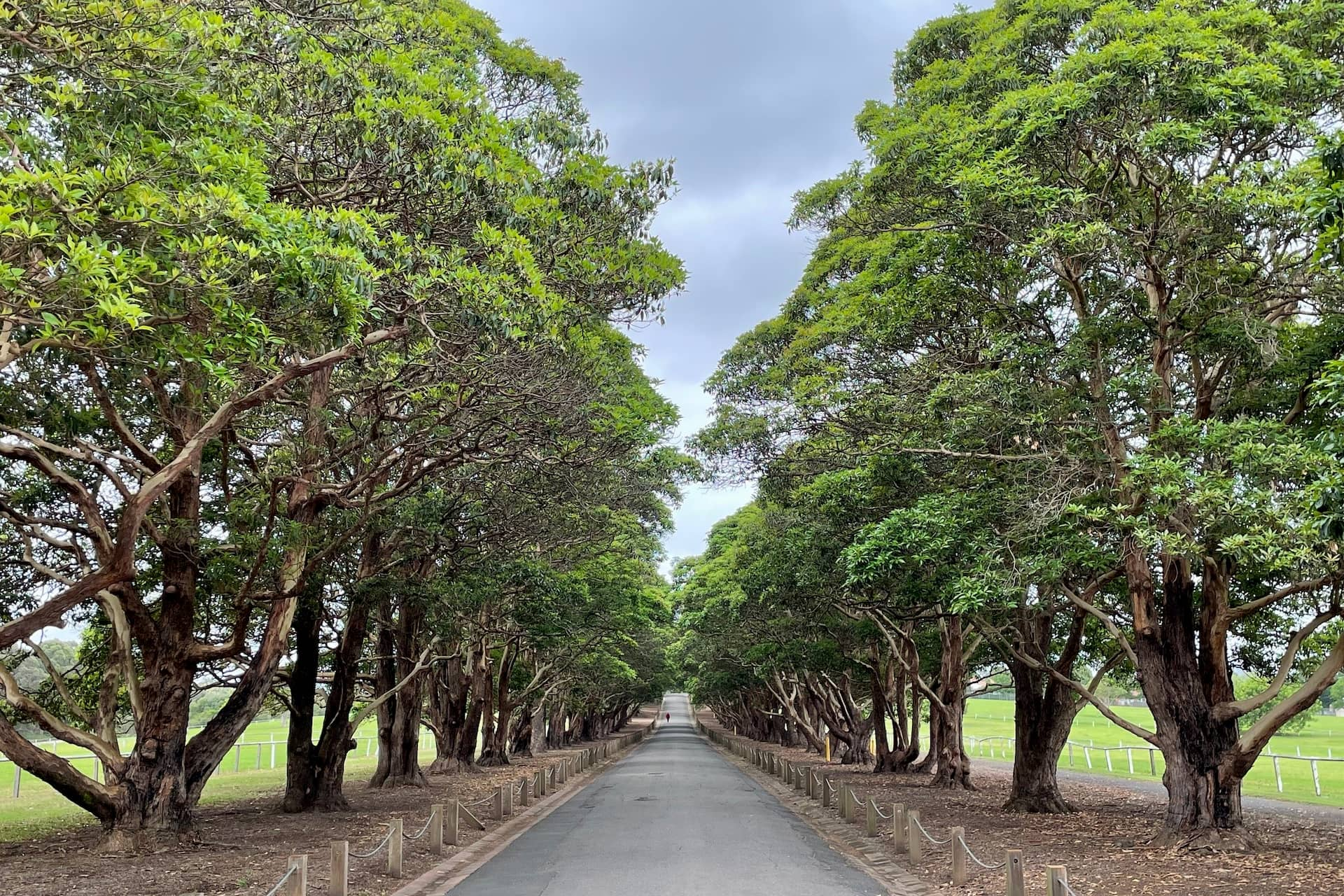
A rainforest tree from Northern NSW and Queensland, this tough species forms the drive’s entry avenue. It lines many suburban Sydney and NSW streets and parks from the Federation era (ca.1880-1920). These brush box trees are squat as they are growing on hard, dry shale (heavy clay/rock) catching wind, and with little water.
Bidwill’s hybrid coral tree
Erythrina x bidwillii ‘Blakei’
| Stop: 2 |
| Location: Island garden bed |
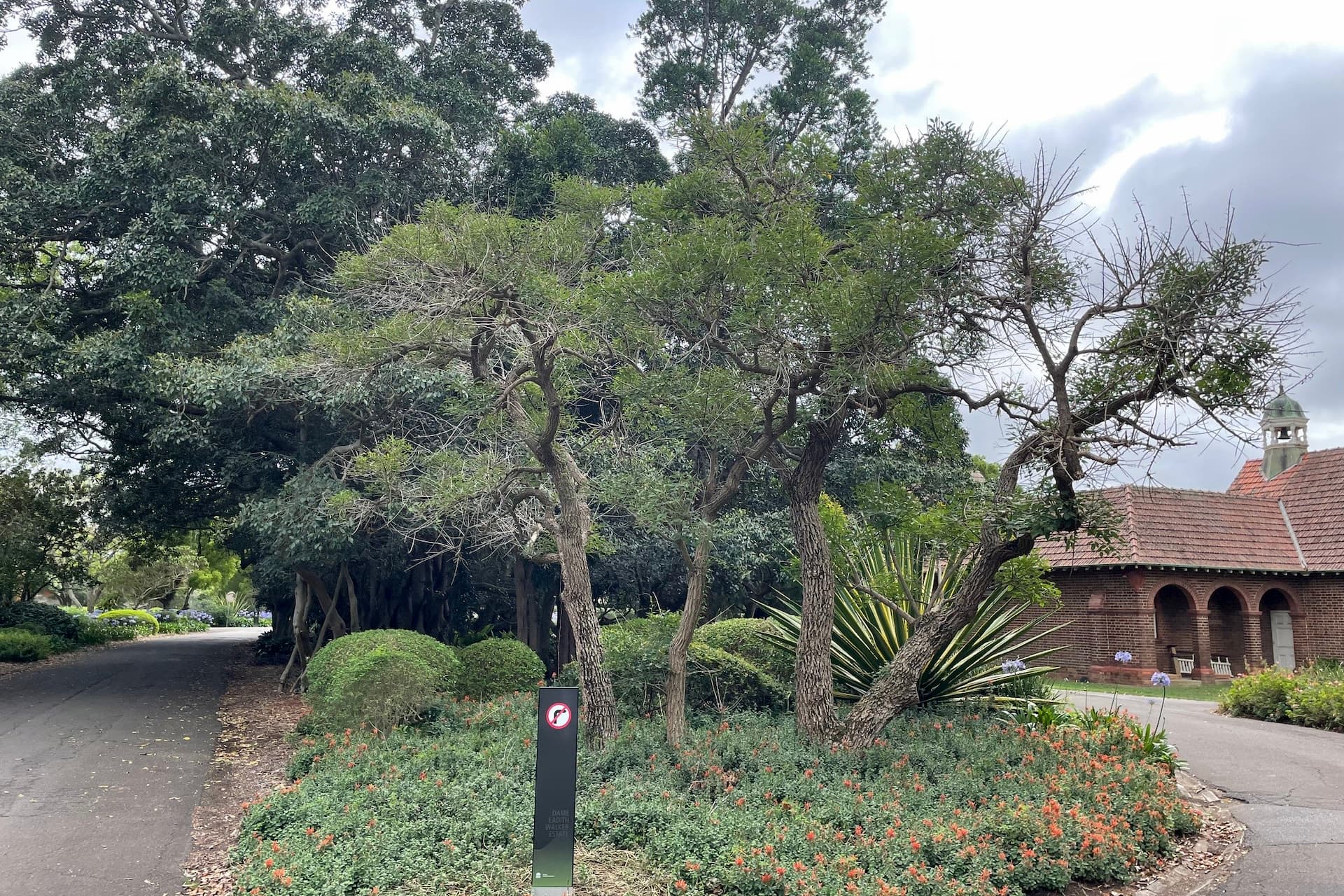
Located in the island garden bed inside the inner gates where the driveway splits, this corky-barked, spiny small tree bears long vermilion-red clusters of pea flowers in summer. The tree’s name honours two people – John Bidwill and Edmund Blake. Bidwill, a merchant and plantsman bred new plants like this at Camden Park Estate for friends, the Macarthurs. Blake was a gardener at Camden Park. The Walkers, keen gardeners, would have known the Macarthurs.
Native tamarind or burranedura
Diploglottis australis
| Stop: 3 |
| Location: Right side past inner gate |
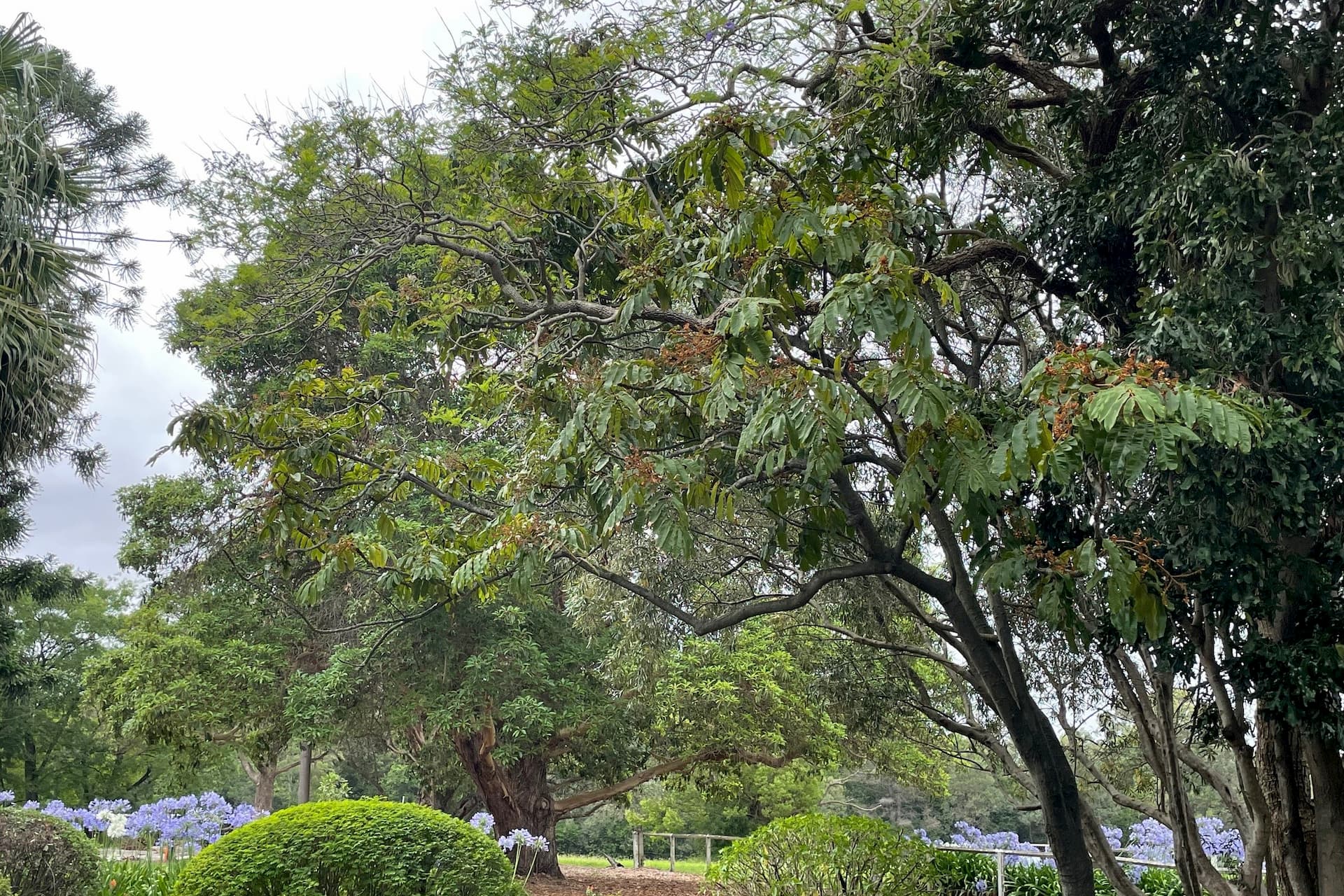
Native tamarind is another native rainforest tree and can be found inside the inner gate on the right near the fence. Feel its large, velvety, golden-haired pinnate leaves. In spring-summer it bears clusters of juicy, sweet-sour, golden, berry-like fruit. It is a component of moist, coastal rainforests and rarely seen in gardens. See if you can spot another, younger native tamarind across the drive.
Port Jackson, rusty fig or dthaaman
Ficus rubiginosa
| Stop: 4 |
| Location: Island garden bed |
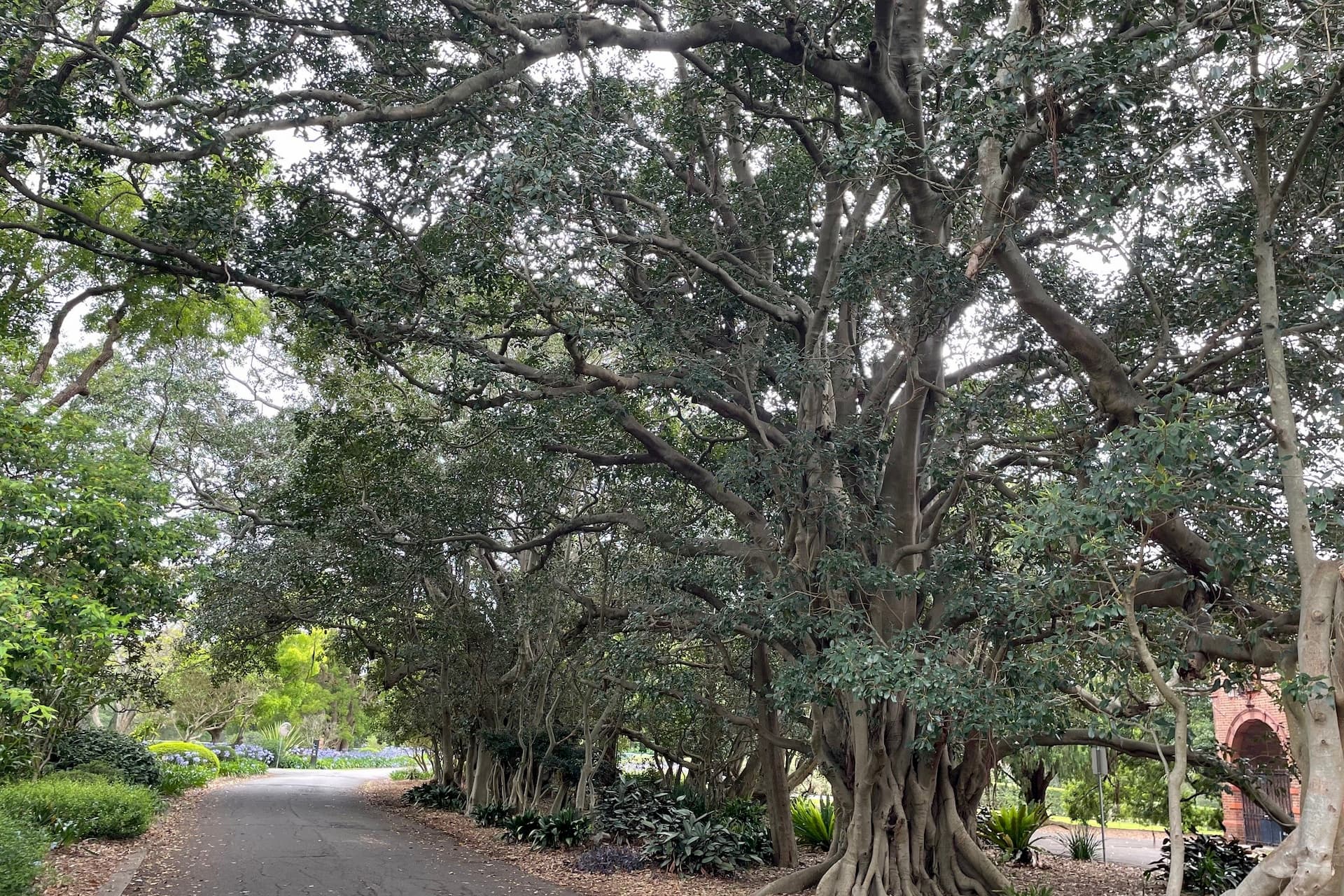
Located inside the main gates, in the middle of the island bed where the driveway splits, are two fine old specimens, and some layered ‘pups’. Yaralla Estate has several large old figs, of this kind and other types. This one is native to coastal NSW and Queensland and has smaller leaves and less aggressive roots than big sister, Moreton Bay fig. Two other huge Port Jackson figs can be found North-West of the front door beyond the Sunken Garden.
Red-wing
Heteropterys glabra
| Stop: 5 |
| Location: Left side past inner gate |
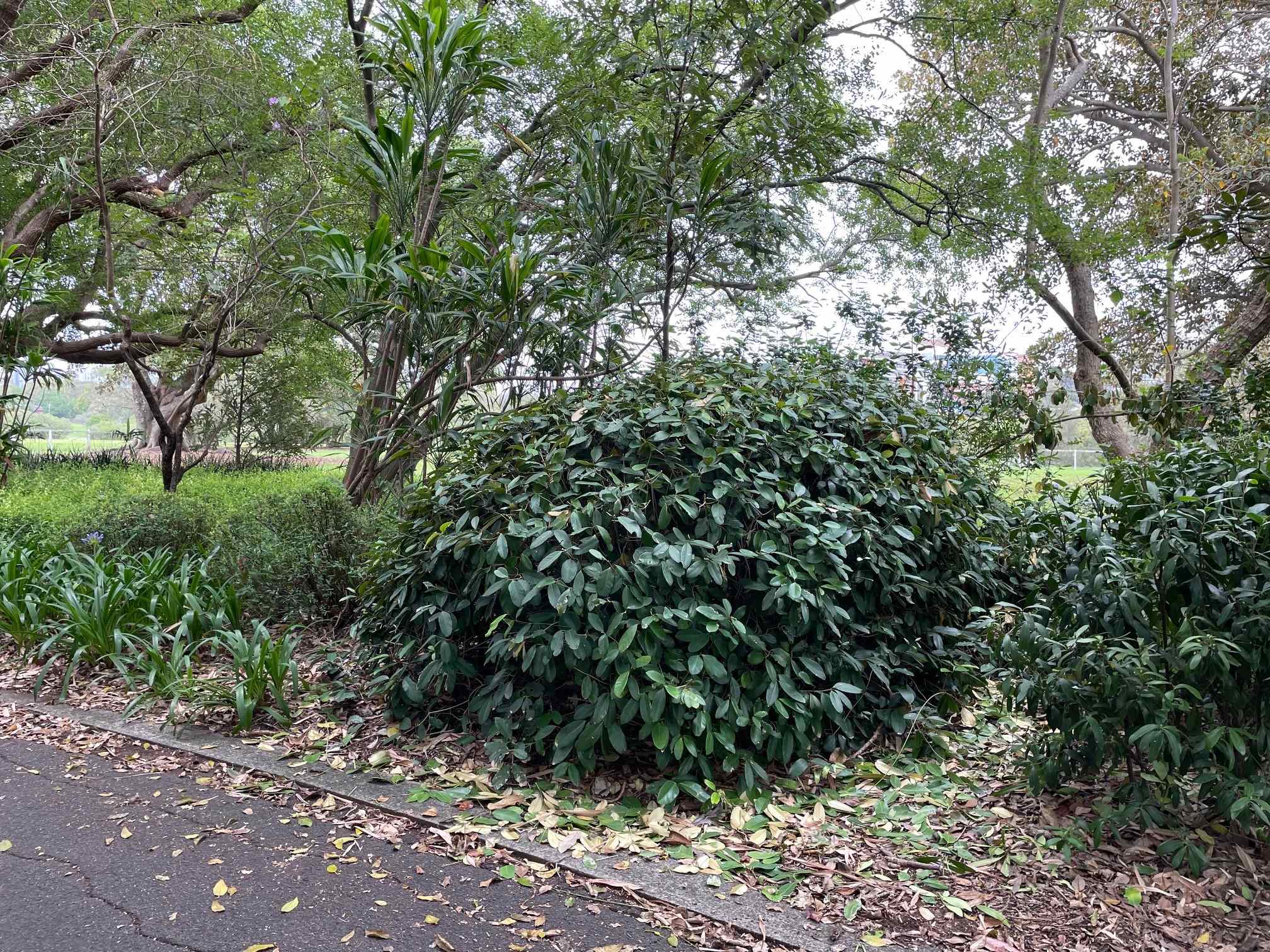
Found along the left-hand side of the main inner drive, is a clipped bush of a large, leathery-leaved, woody vine from Argentina and Southern Brazil. Sprays of gold flowers appear in early summer followed quickly by brilliant red fruits that resemble sycamore wings. A very rare specimen, with just one other in Sydney found in the Royal Botanic Gardens.
Moreton Bay fig, karreuaira or waabie
Ficus macrophylla
| Stop: 6 |
| Location: Left side past inner gate |
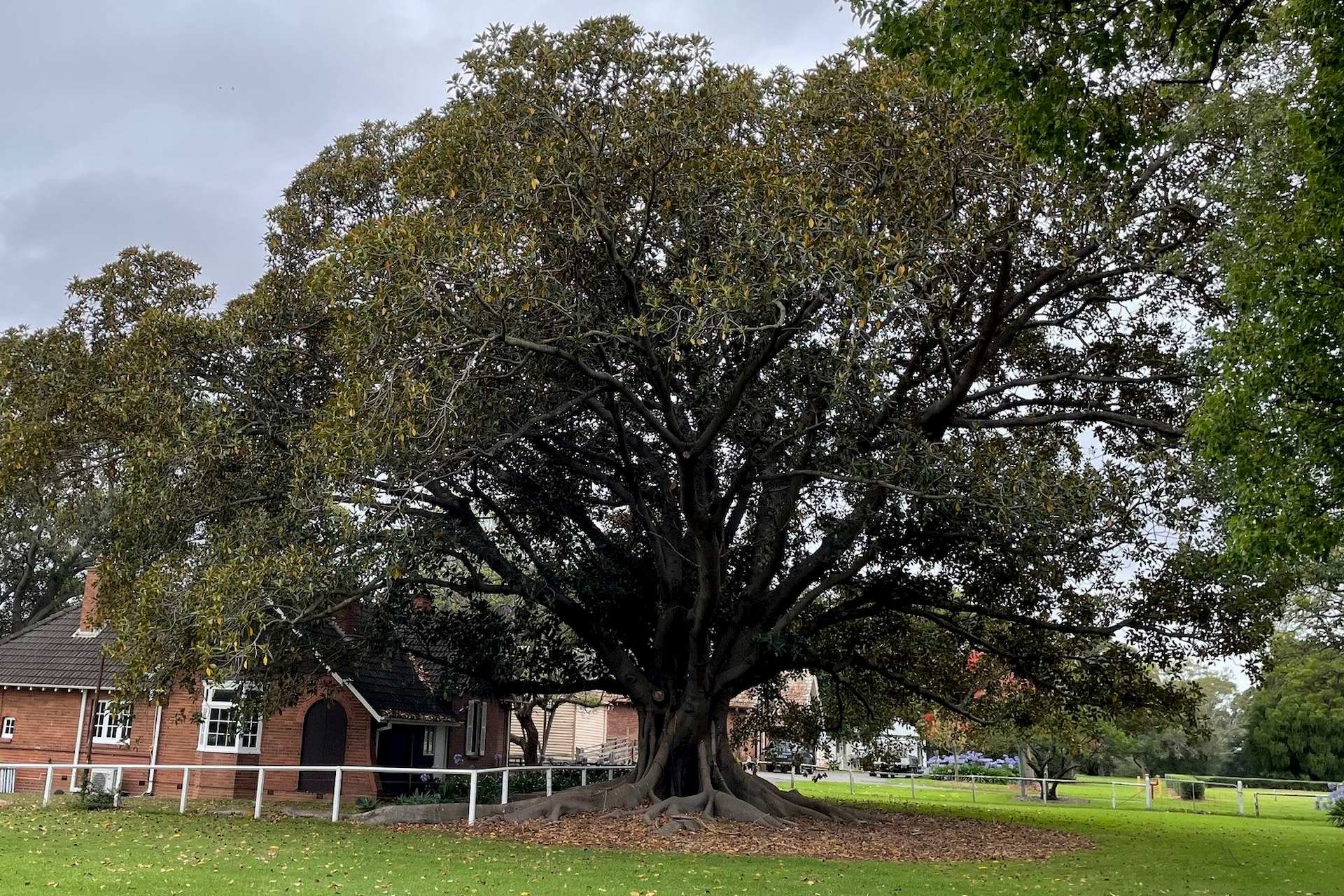
This enormous fig can be found on the left-hand side of the drive, towering over the paddock near the old estate dairy cottage. Note its pronounced trunk buttresses, and its leaves that are smooth, gold-coloured, and larger than the leaves and fruit on the Port Jackson fig.
Mexican blood trumpet, scarlet trumpet vine or red bignonia
Distictis buccinatoria
| Stop: 7 |
| Location: West side of rose garden |
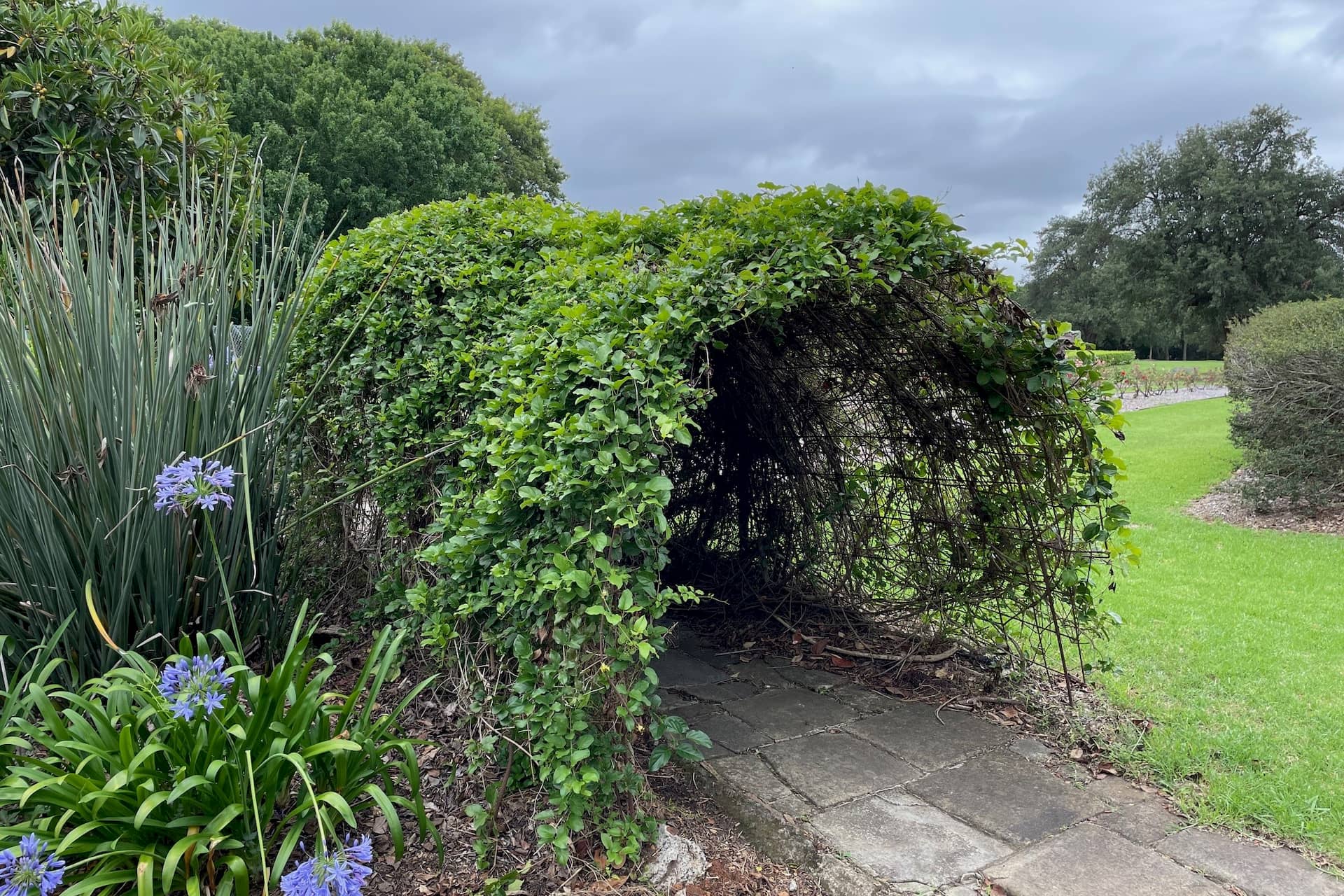
Spread over a crinkle-wire tunnel arbor to the right of the driveway facing the Rose Garden, this vigorous creeper vine from Mexico grows hot pink or magenta trumpet-shaped flowers.
Mauritius hemp
Furcraea selloa ‘Marginata’
| Stop: 8 |
| Location: Roadside |
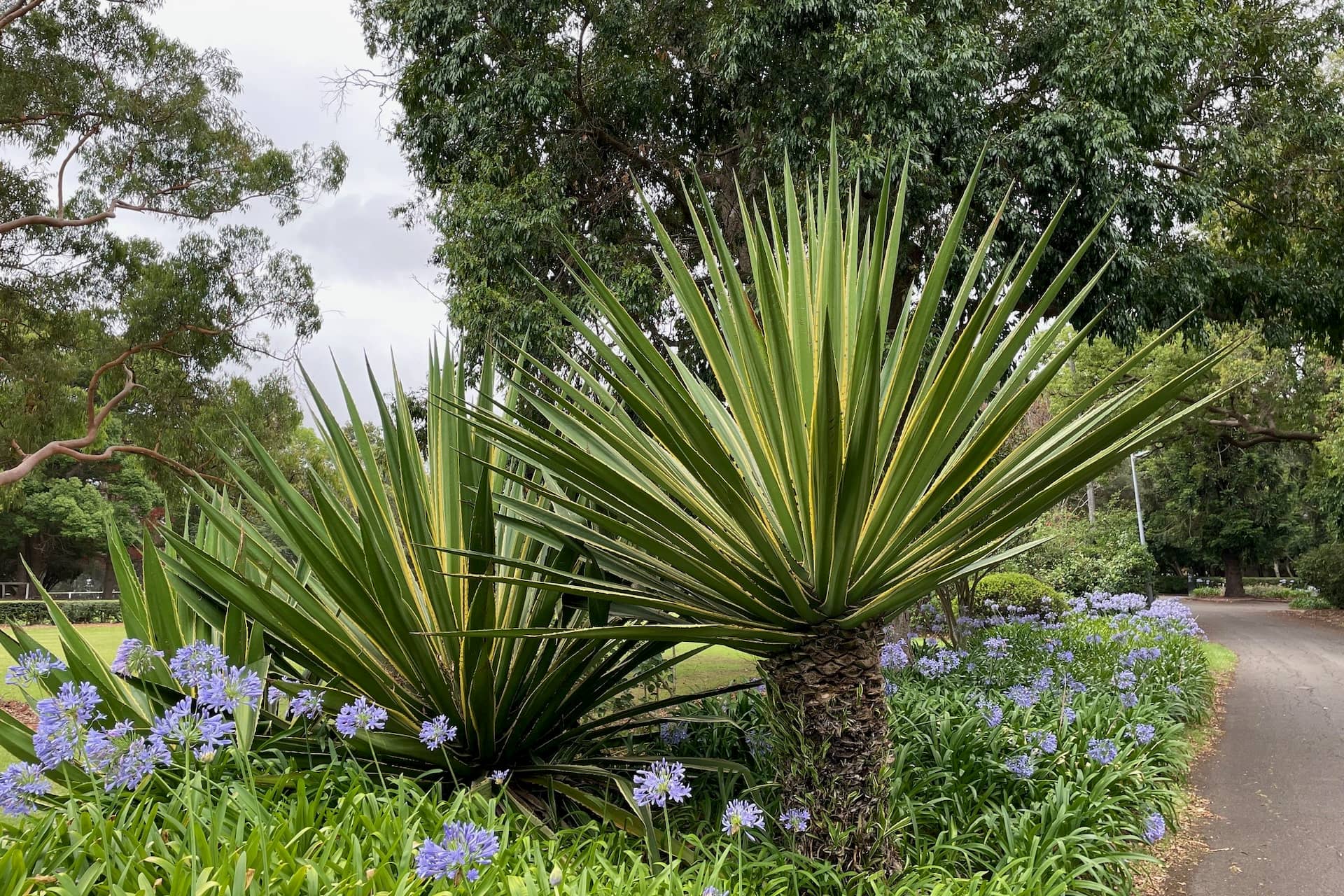
Beyond the island bed, on both sides of the drive are giant, spiky succulents. They grow rosettes, which sprout trunklets and then huge ‘fishing rods’ of flowers which turn into multitudes of satellite baby plantlets. Once an important economic crop for fibre (for rope, twine, cloth), ‘spikies’ were high fashion in Victorian and Edwardian bedding schemes and shrubberies.
Poison bush or wintersweet
Acokanthera oppositifolia
| Stop: 9 |
| Location: Roadside left |
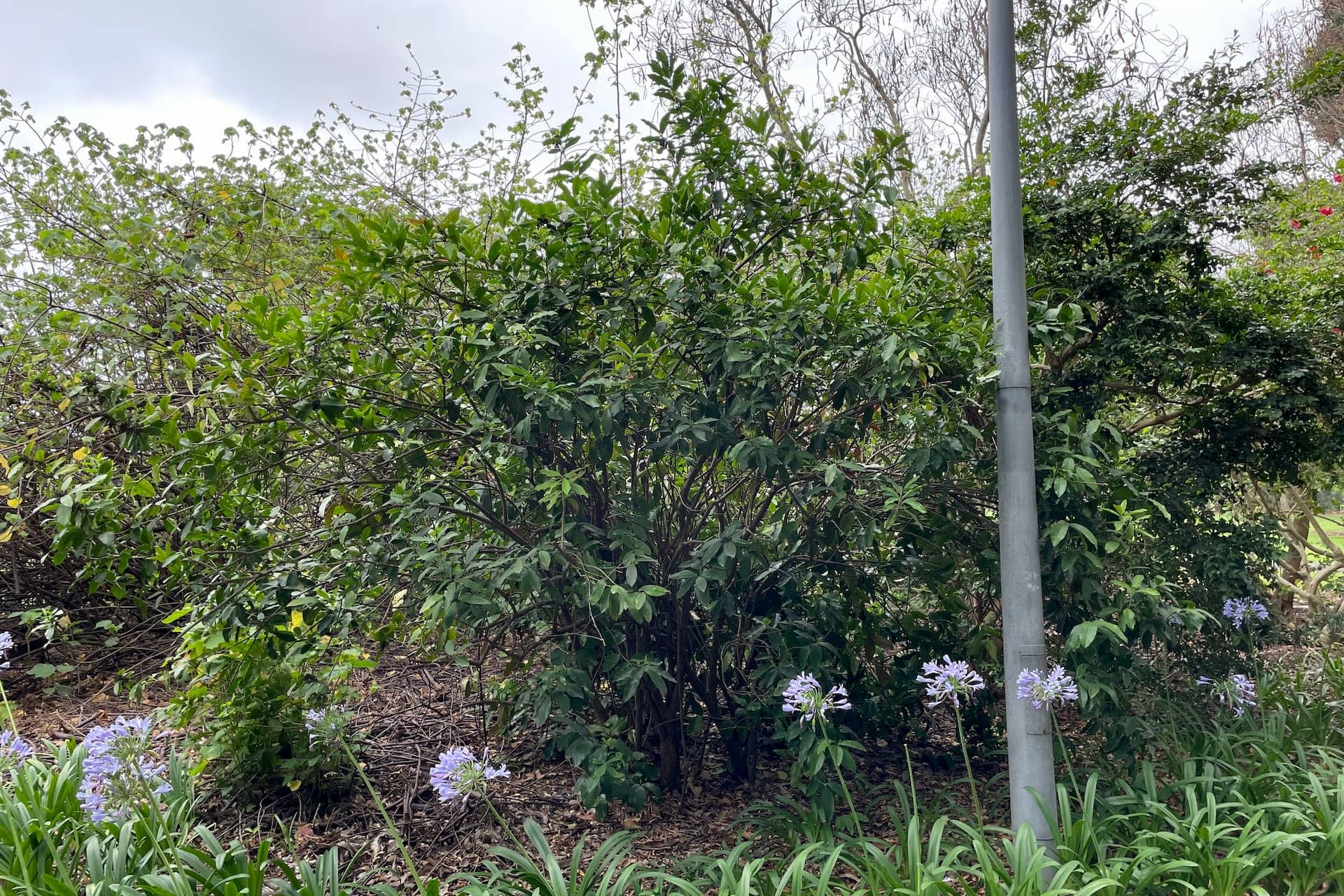
Located a little further down on the left side of the drive, this bush flowers in September with perfumed clusters of jasmine-like flowers and olive-shaped inedible toxic fruit. Used by South African tribes as poison in hunting, this tough, old-fashioned shiny-leaved bush quietly grows in the shrubbery, unaffected by droughty spells.
Turpentine or Booreah
Syncarpia glomulifera
| Stop: 10 |
| Location: Roadside right |
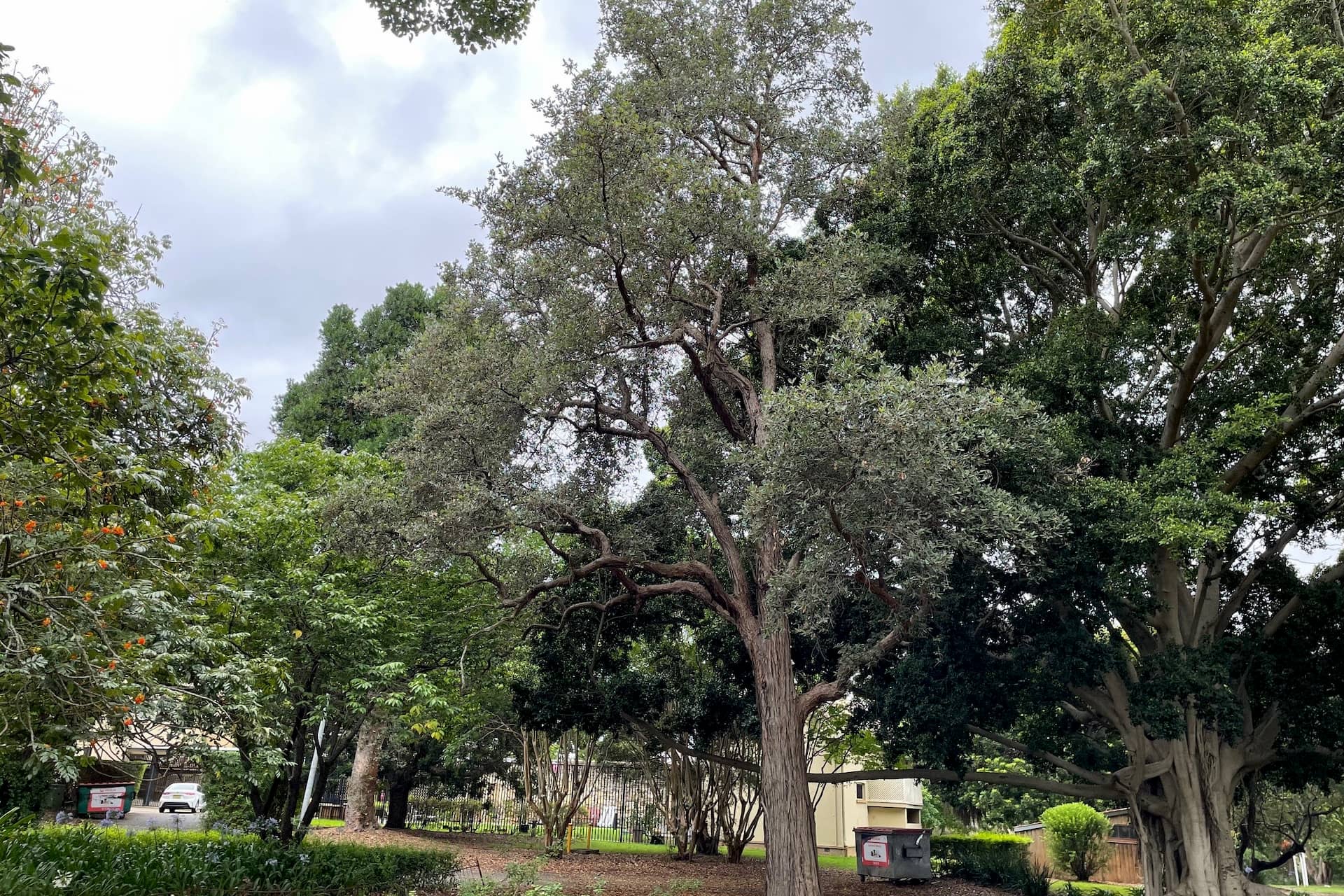
Turpentine is one of the key component trees of turpentine-ironbark forests, an endangered community found on heavier clay shale soils in inland Sydney. Yaralla Estate has two remnant forests of turpentine-ironbark including that surrounding the Rose Garden. The trees rough, corrugated bark, rustic structure and stiff, shiny leaves give it a distinct look. Flowers are quite different from eucalypts as are its fruits.
Gunbarrel, brown birch or mountain cherry tree
Scolopia braunii
| Stop: 11 |
| Location: Right island near house |
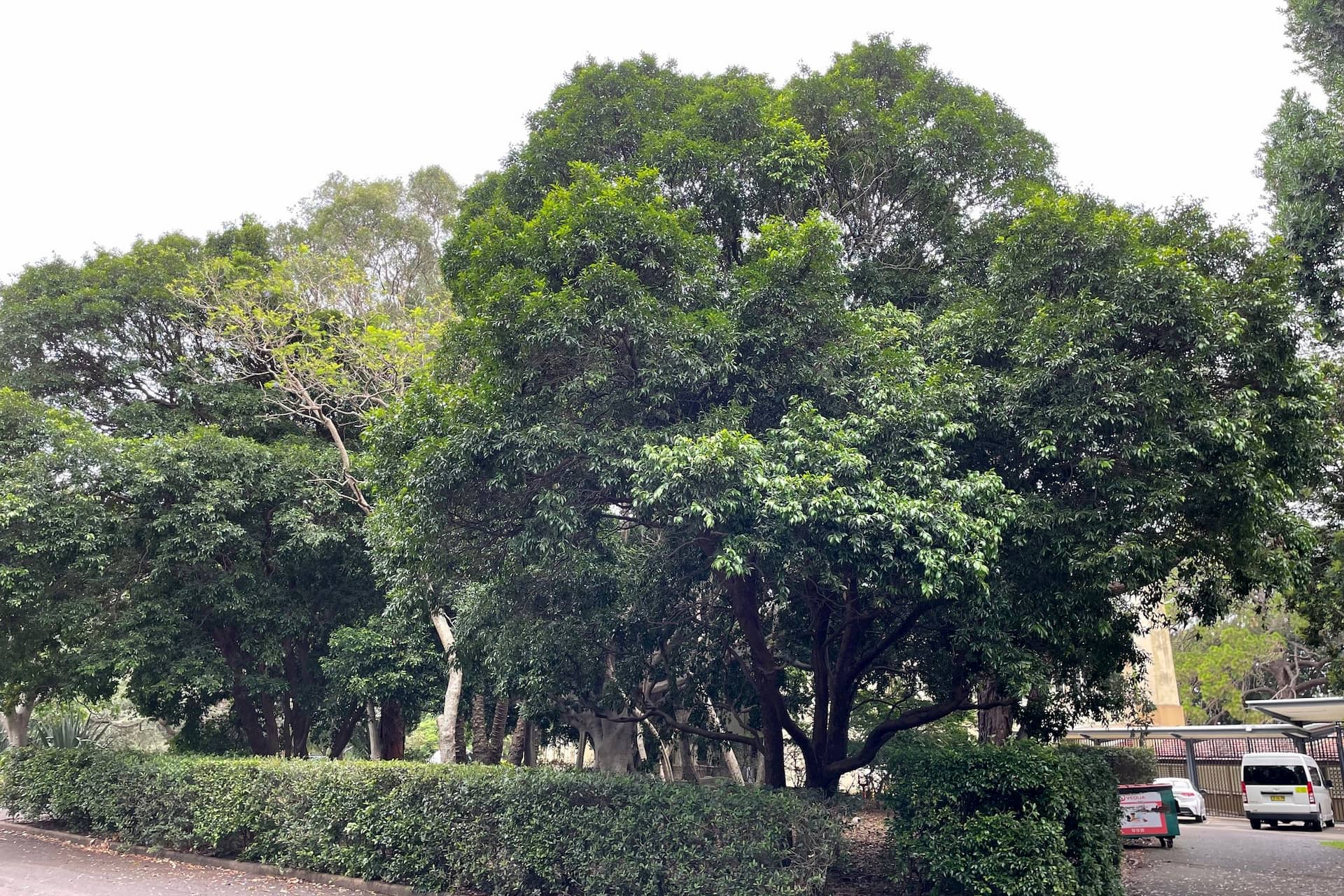
Found in a grove to the left of Yaralla House, this coastal native rainforest tree is slow growing but with wood so hard it was favoured for making gun-butts. It has small, diamond-shaped leaves and produces cherry-like fruit from December to April.
Himalayan or deodar cedar
Cedrus deodara
| Stop: 12 |
| Location: Main turning circle |
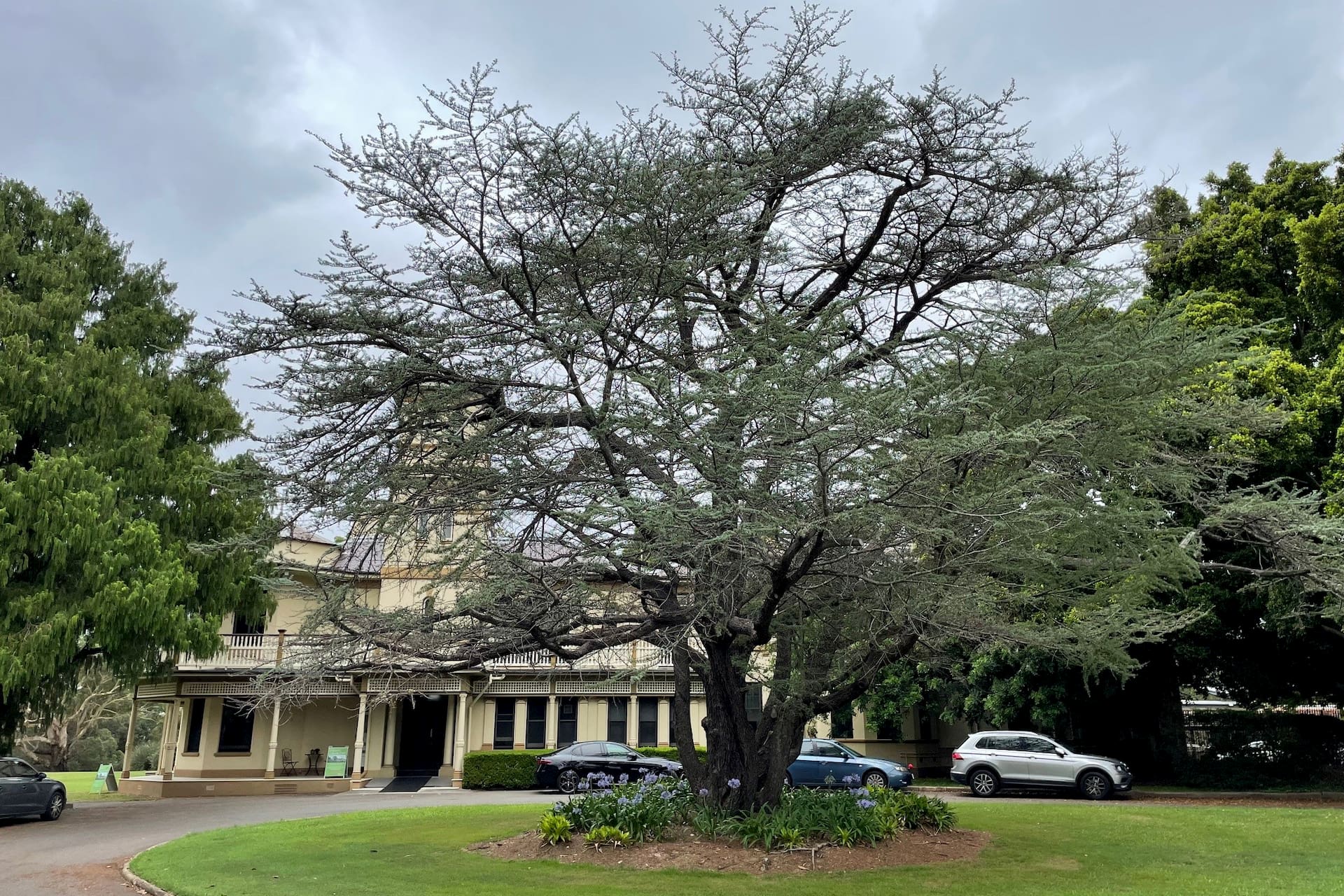
This stunning tree is located in the turning circle island near Yaralla House front doors. This specimen shows the importance of conifers to gardens of any size or pretension. In 1865 it was referred to as a fine specimen. Formality of shape was favoured, and the tendency to form horizontal branches. This is Pakistan’s national tree and found across the Himalayas.
Bangalay or southern mahogany
Eucalyptus botryoides
| Stop: 13 |
| Location: North side towards Sunken Garden |
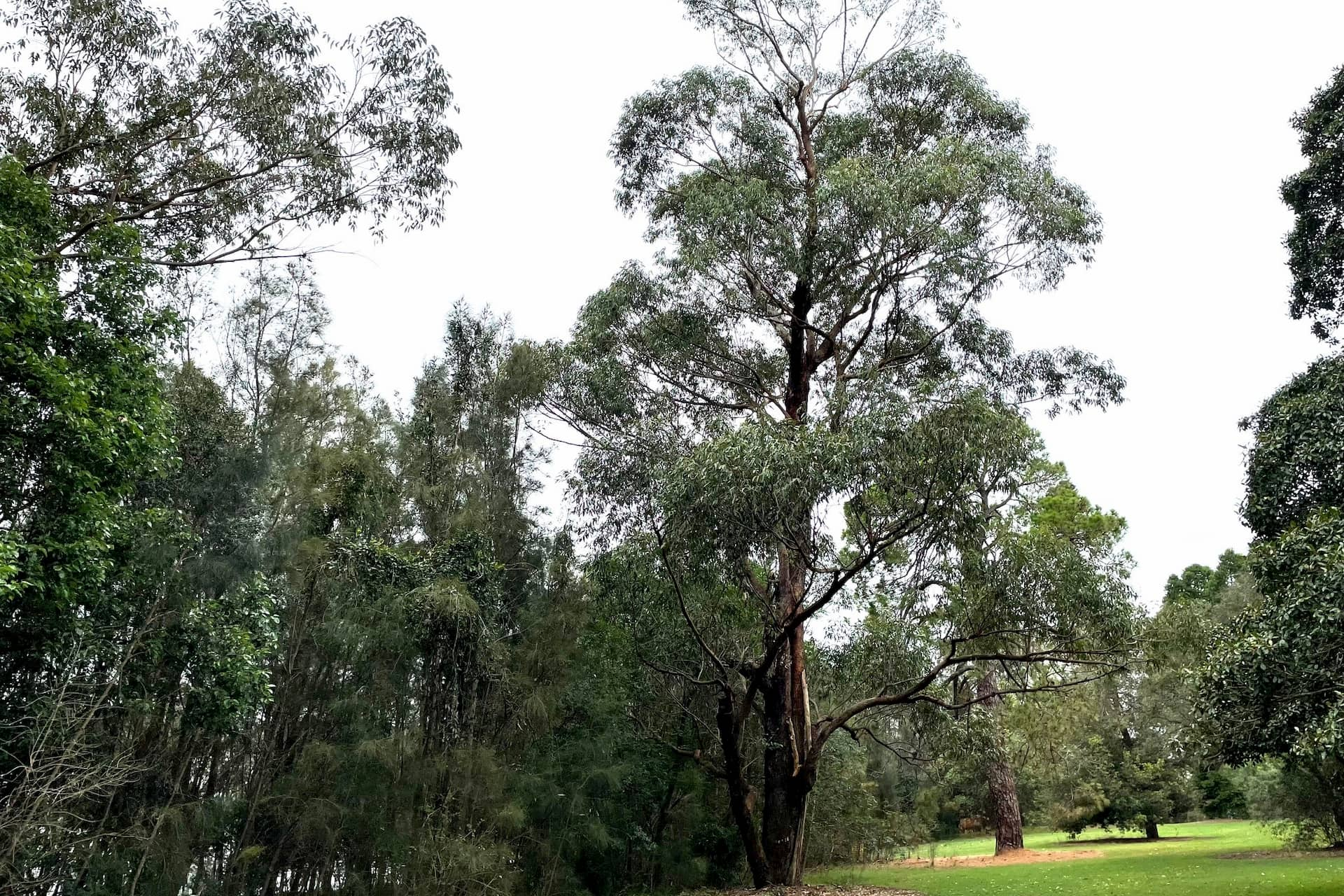
Located to the North-East of the Sunken Garden, the Bangalay can reach up to 30 metres high with rough, reddish bark, short trunks and spreading crowns. It usually grows with banksias on sand dunes in coastal rainforest areas. Their thick bark was collected by Aboriginal people to make canoe hulls.
Giant bamboo
Dendrocalamus giganteus
| Stop: 14 |
| Location: North side towards Sunken garden |
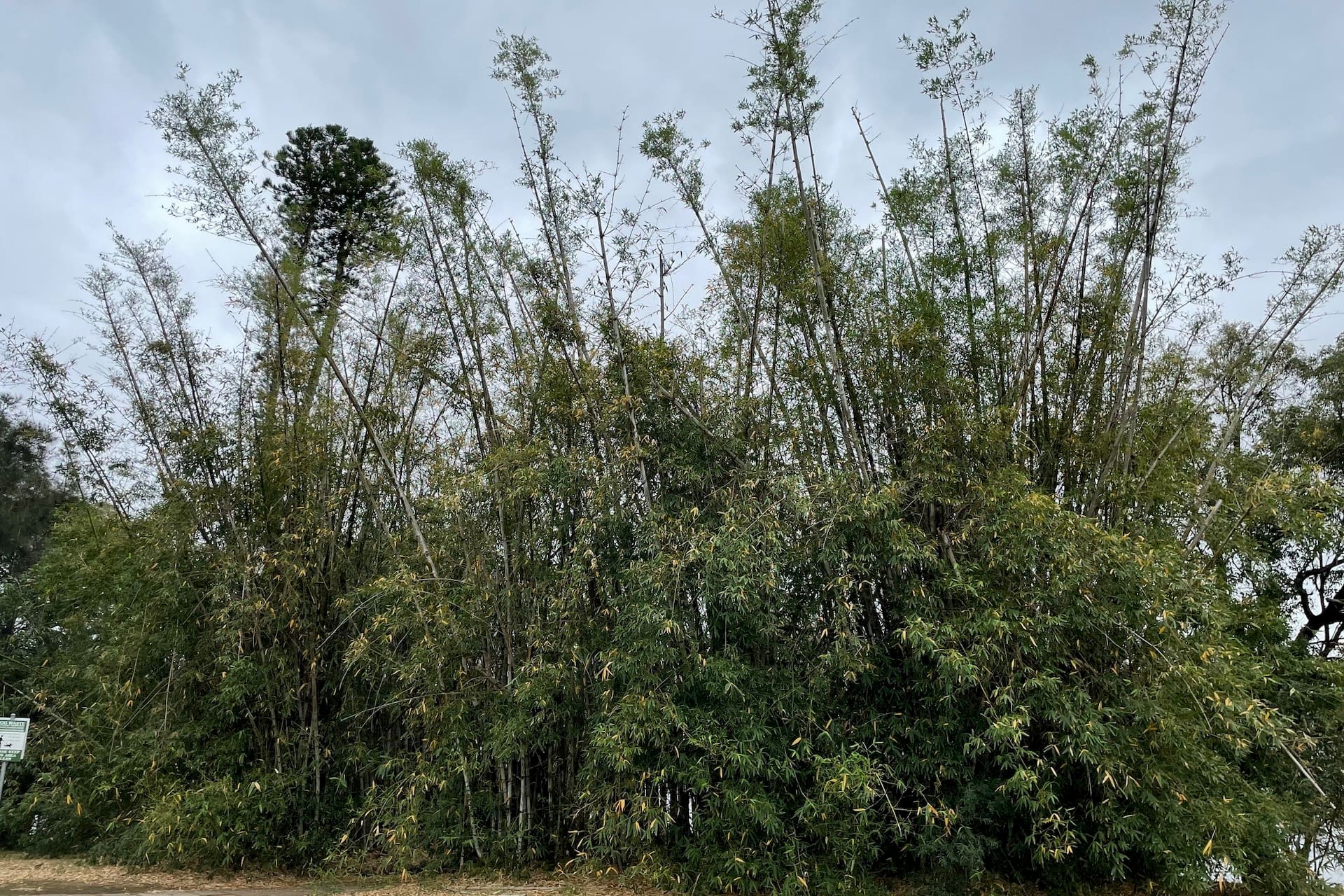
Two groves of giant bamboo mark the Estate’s Water Gate entry on Parramatta River, where a now long-gone pier and boatshed previously existed. It was once the main means of transport to and from the Estate.
Valley bush or big-toothed milk tree
Euphorbia grandidens
| Stop: 15 |
| Location: North side Concord Foreshore Trail |
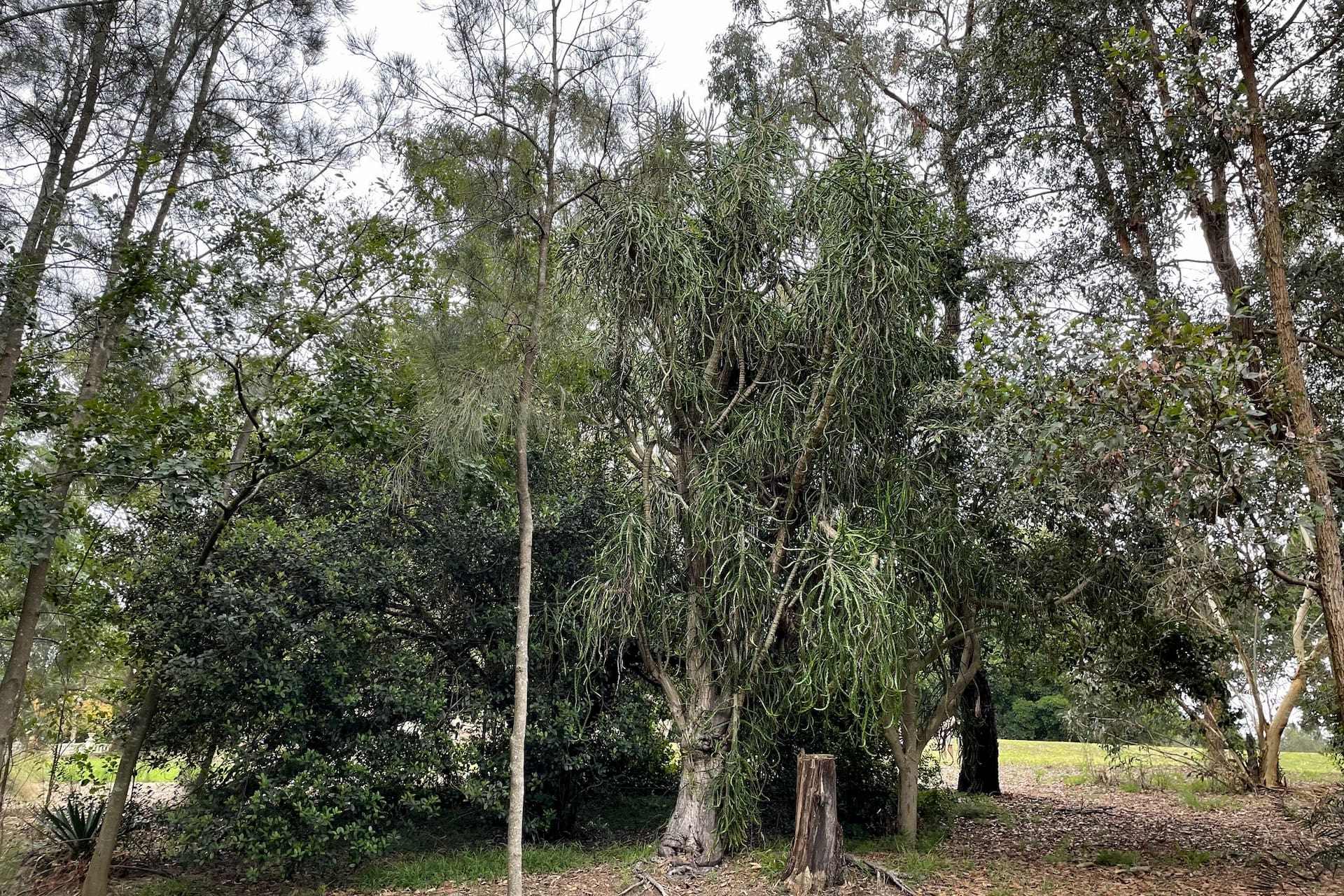
Found along the Concord Foreshore Trail, this gangly, succulent tree with tiny leaves and snaking, clustered branchlet stems, originates from Africa’s dry South-Eastern woodlands. This specimen is almost as tall as one in the Royal Botanic Gardens but is less dense. Like the poison bush, it has milky sap which is both toxic but medicinally useful.
Grotto wonders
| Stop: 16 |
| Location: East side near Concord Foreshore Trail |
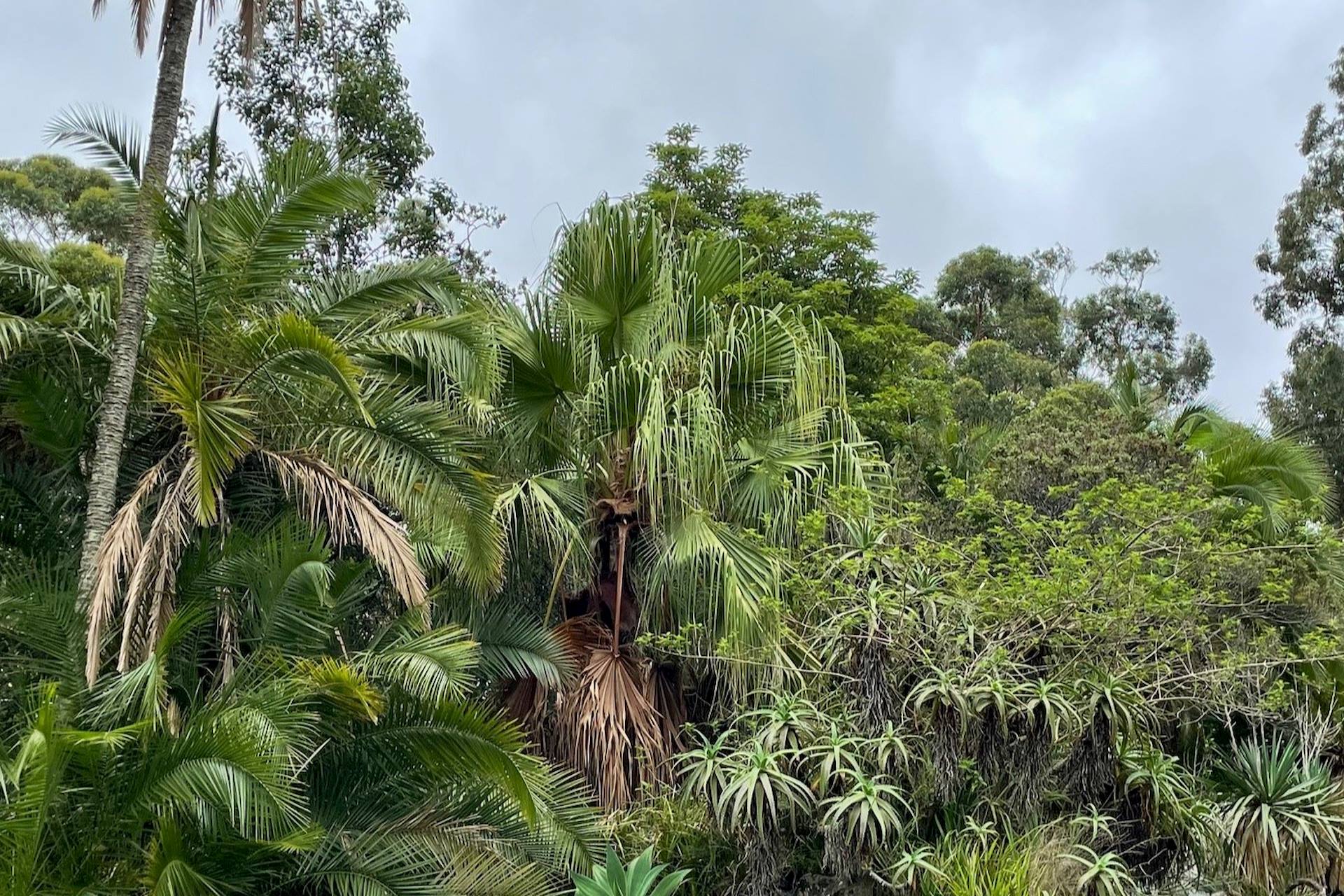
The Grotto is rich in succulents, spiky plants, palms and oddities including an endangered Chinese fan palm (Livistona chinensis) with large round ‘weeping’ fronds (pictured). There is also a Senegal date palm (Phoenix senegalensis) with multiple trunks, and Trachelospermum asiaticum, a low-growing scrambler with mottled leaves, a cousin of the widely-grown star jasmine climber, Trachelospermum jasminoides.
Chir or long-needled Himalayan pines
Pinus roxburghii
| Stop: 17 |
| Location: Behind Yaralla House |
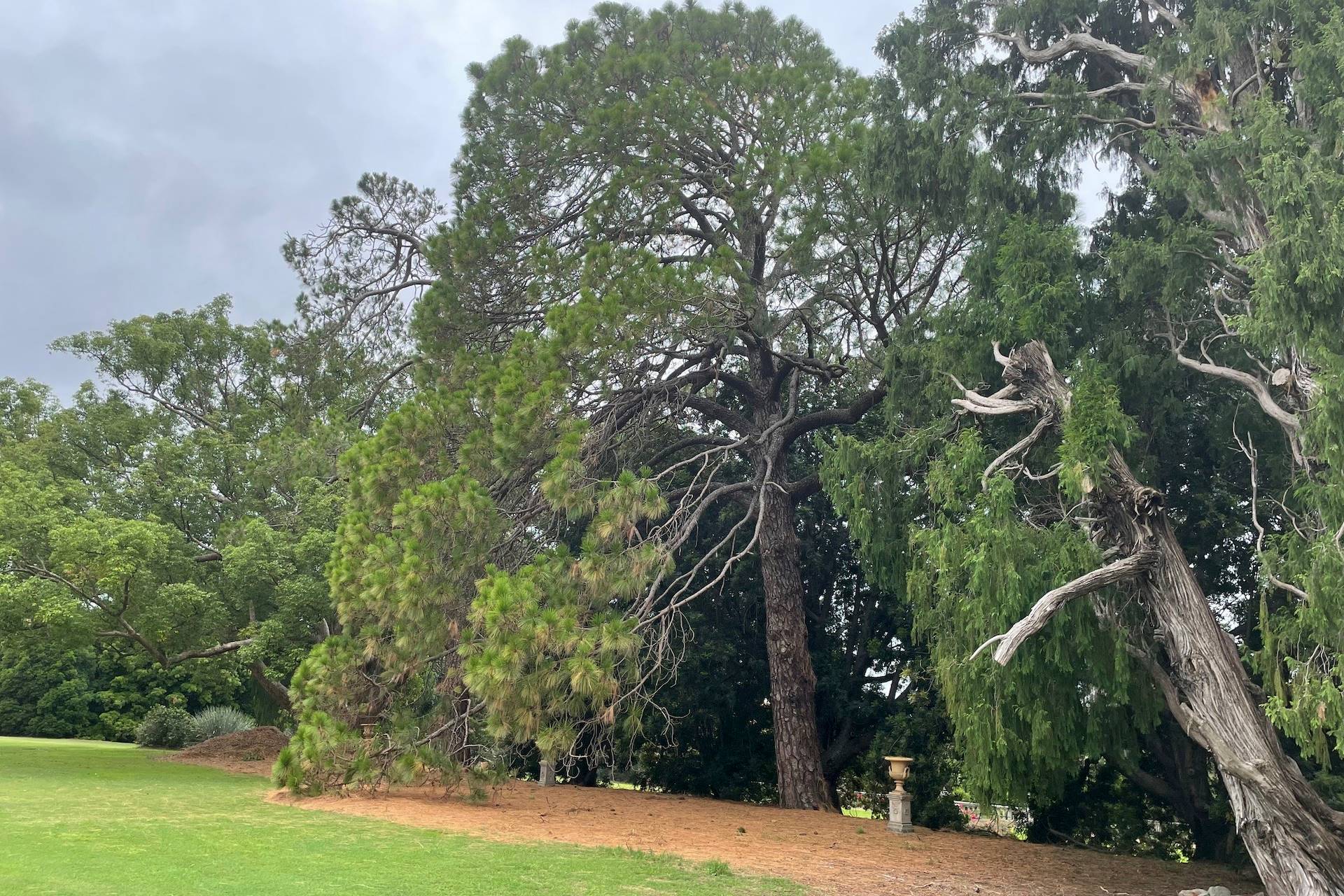
A line of these rare pines grace the Eastern edge of the main lawn outside Yaralla House and frame a central path down to the Italian Garden and Grotto. Another tall specimen is North of the former tennis court and front lawn towards to water’s edge.
Japanese raisin tree
Hovenia dulcis
| Stop: 18 |
| Location: Behind Yaralla House |
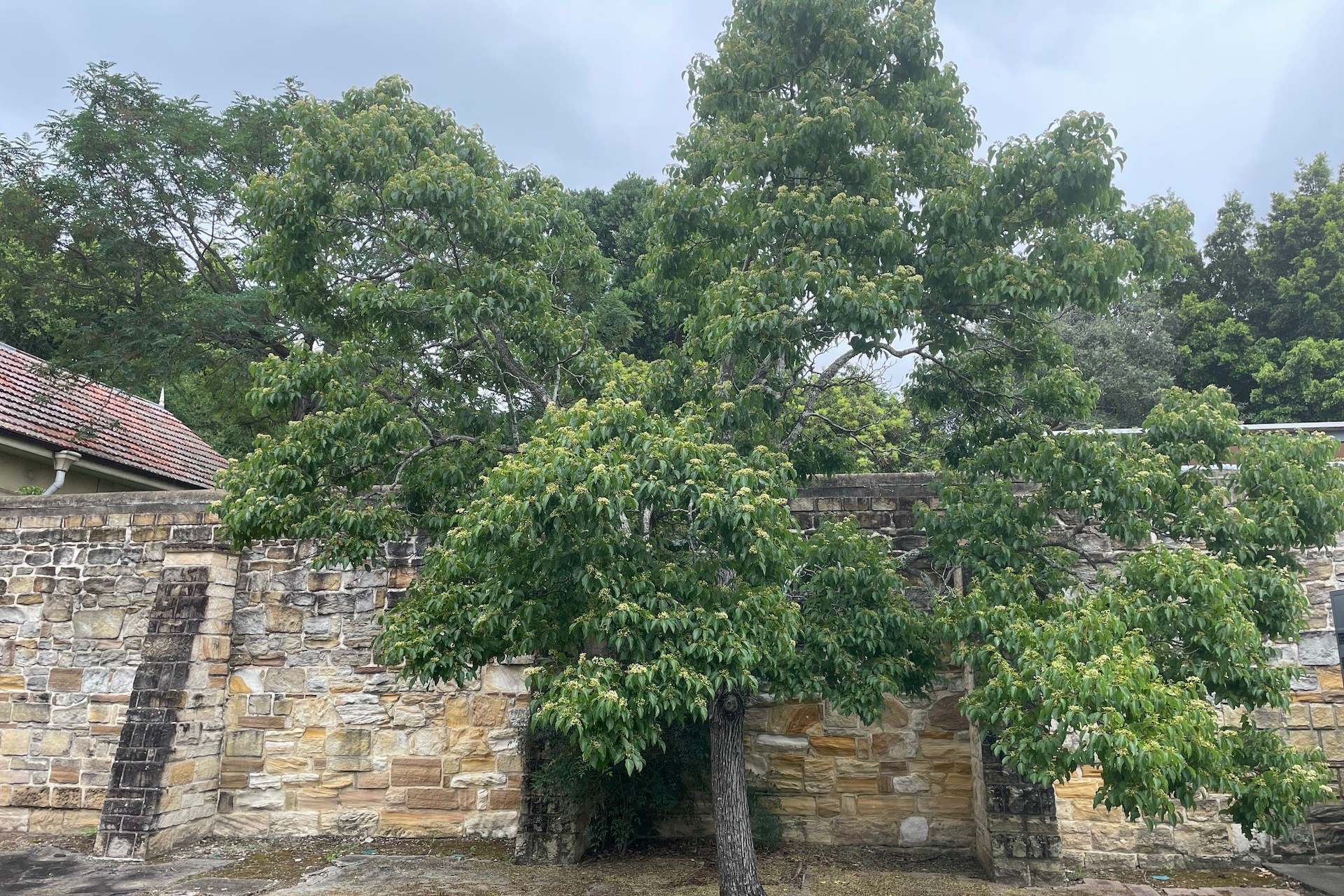
Found along the edge of Yaralla Houses’ rear-service courtyard are two of these extremely rare trees. They have shiny, pointed, smart leaves similar to a giant pear, and produce edible fruit that taste like raisins.
Wilga or native willow
Geijera parvifolia
| Stop: 19 |
| Location: North side of Rose Garden |
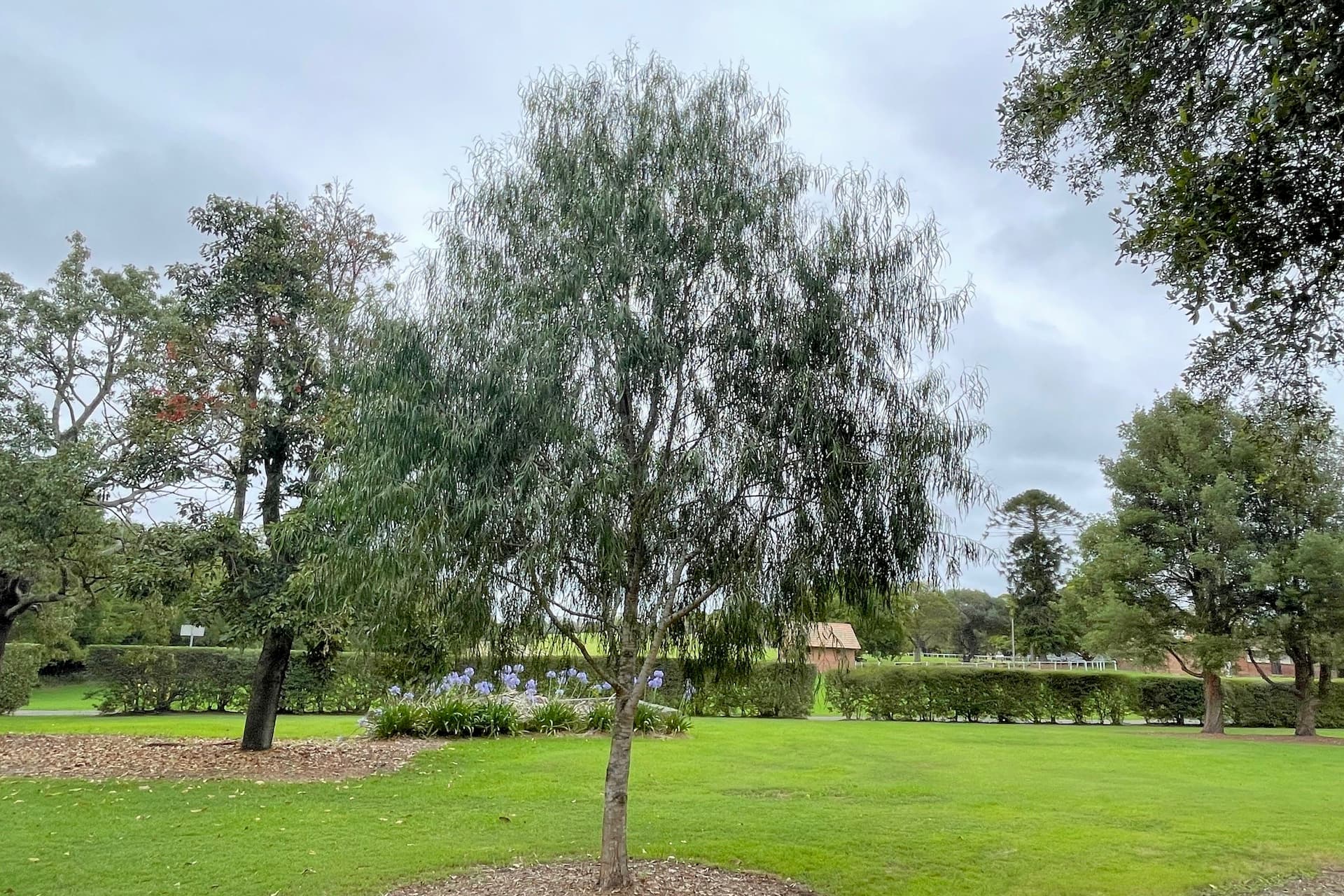
Wilga is an inland, dry-country tree, with linear, elegant, drooping leaves like a weeping willow. Rarely seen on the coast, a young one grows in the Rose Garden near the Kalparrin Day Care Centre, also known as Magnolia Cottage (the engineers cottage).
Grey mangroves or janji
Avicennia marina var. australasica
| Stop: 20 |
| Location: Concord Foreshore Trail |
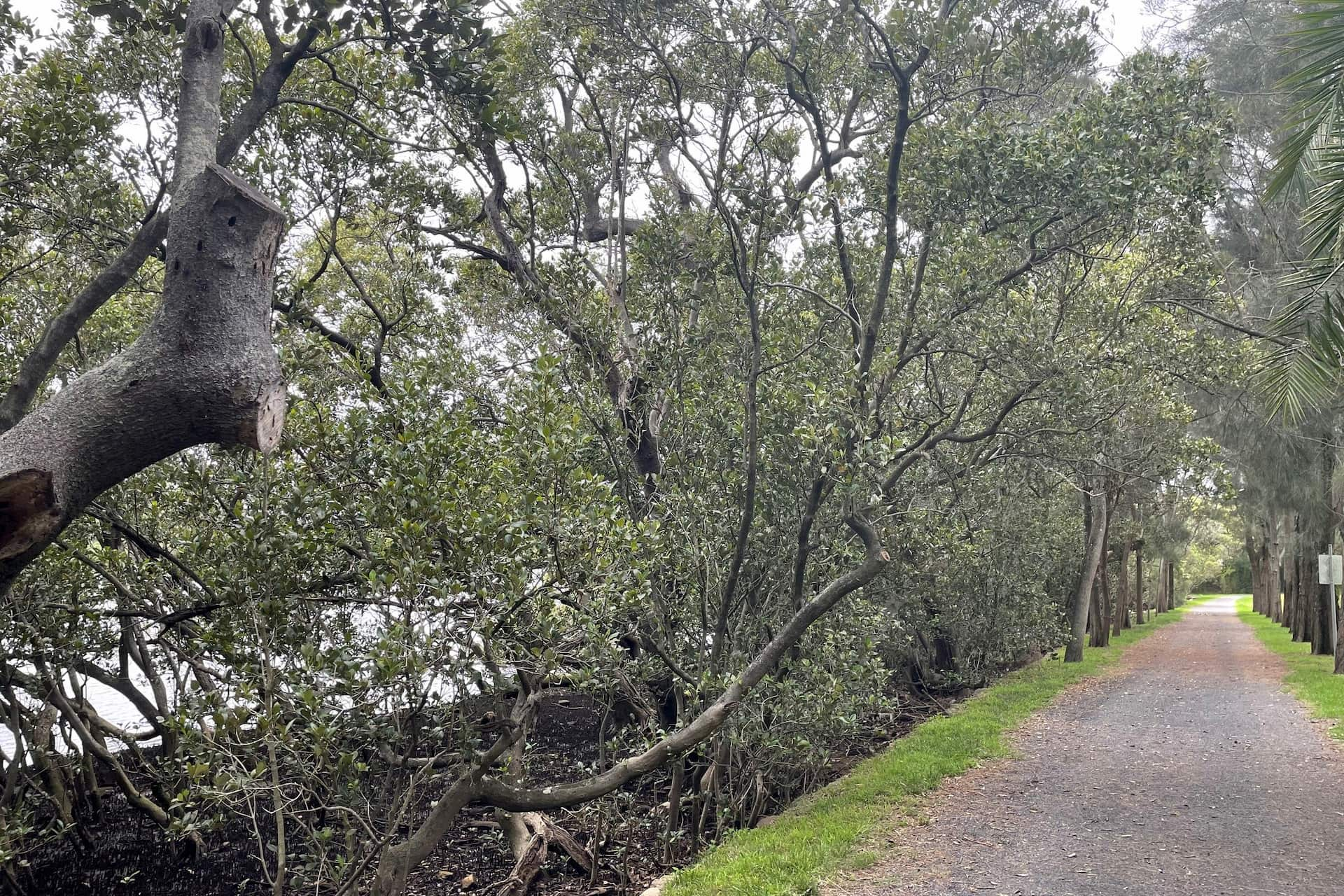
Mangroves colonise the tidal foreshores with their asparagus-like ‘breathing roots’ or ‘pneumatophores’. Historic Parramatta River photographs show none, suggesting they were cut down to facilitate foreshore access and water views, and regenerated at a later date.

